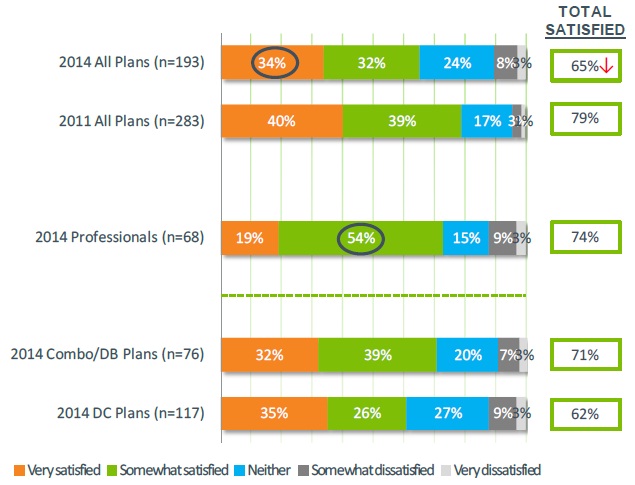
POR Registration Number: POR 015-13
PWGSC Contract number: 59017-130044/001/CY
Contract award date: May 23, 2014
Report Delivery date: March 25, 2015
Prepared for the: Office of the Superintendent of Financial Institutions (OSFI)
Ce rapport est aussi disponible en français.
For more information on this report, please e-mail:
information@osfi-bsif.gc.ca
Prepared by:
Harris/Decima Inc.
Harris/Decima is pleased to present this report to the Office of the Superintendent of Financial Institutions (OSFI) highlighting the results of the 2014 Pension Plans Survey among pension plan administrators and professional advisors.
OSFI is the primary regulator and supervisor of federally regulated financial institutions and federally administered pension plans. To help OSFI assess how well it is achieving its mandate, OSFI undertakes consultations with senior executives within the financial community for their perceptions of OSFI's performance.
OSFI's stakeholder consultations program incorporates rotating surveys with various industry sectors, generally administered every two to three years. In 2014-2015, OSFI undertook a survey of federally regulated private pension plans. The previous consultation was done in 2011-2012.
The research will provide the data needed to meet OSFI's performance reporting commitments and will also enable OSFI's Private Pension Plans Division (PPPD) to identify areas for improvement.
The primary objectives of this survey were to:
To meet these objectives, an attempted census survey was executed in order to maximize completion rates with a finite sample. An online survey was conducted with pension plan administrators and professionals (including actuaries, consultants, lawyers, third-party administrators and custodians) who regularly deal with OSFI on behalf of pension plans. The survey was administered online followed by a telephone campaign to remind respondents to participate in the survey. The follow-up calls offered respondents the option to complete the survey over the phone. This differs somewhat from the approach taken in previous waves of the survey where some participants were initially invited to participate via phone while others were invited to participate via e-mail. Surveys from either an online or telephone approach were available in English and French with 236 and 36 surveys completed in each language, respectively.
In total, 272 surveys were completed between November 12, 2014 and December 15, 2014, including the pre-test, as follows:
From the universe of 918 potential participants, 272 completed surveys yields a participation rate of 30%.
| Number of completions | Response rate 2014 | Response rate 2011 | |
|---|---|---|---|
| Overall response rate | 272 | 30% | 36% |
| Defined Benefit Plan Administrators | 54 | 35% | 44% |
| Defined Contribution Plan Administrators | 126 | 28% | 35% |
| Professionals | 69 | 30% | 24% |
| Combination Plans | 23 | 28% | 34% |
Since the entire population of active pension plans (with assets over $500k) regulated by OSFI was invited to participate in this study there is no margin of sampling error to be estimated or reported.
A detailed description of how the research was completed is provided in the Appendix.
Throughout this report, the following are important to note:
Where possible, comparisons to the 2008 and 2011 data are made. All research instruments are included in the Appendix.
This report is divided into seven broad sections. The first section discusses participants' overall satisfaction with OSFI. This is followed by an overview of the perceptions participants hold about OSFI's guidance. The third part of this report explores OSFI's role as a supervisor, followed by a discussion of the approvals process. The fifth section provides an overview of the information and communications provided by OSFI. This is followed by a discussion of the Regulatory Reporting System (RRS). The last section provides an overview of additional comments provided by participants.
The 2014 survey results reveal a statistically significant decrease in overall satisfaction with OSFI as a regulator and supervisor of private pension plans compared to 2011. Currently, two-thirds (65%) of plan administrators are either very or somewhat satisfied with OSFI as a regulator, including one-third (34%) who say they are very satisfied.
Graph 1 – Overall Satisfaction with OSFI – Comparison between Plan Administrators and Professionals

BASE: All valid responses (n=261)
Q2a: Overall, how satisfied or dissatisfied are you with OSFI as a regulator and supervisor of private pension plans?
When compared to previous years' results, overall satisfaction has decreased by fourteen percentage points since 2011 (79%), but is more in line with the satisfaction level seen in 2008 (64%).
Though not statistically significant, defined contribution plan administrators provide slightly lower satisfaction ratings (62%) when compared to combination/defined benefit plan administrators (71%) and professionals (74%). Plan administrators (34%) are more likely than professionals (19%) to say they are very satisfied while professionals (54%) are more likely than plan administrators (32%) to be somewhat satisfied.
Plan administrators and professionals were asked to provide open-ended comments to elaborate on their rating of overall satisfaction with OSFI. Among plan administrators, unprompted reasons for satisfaction tend to relate to good staff (25%) and communication (15%). Conversely, unprompted reasons for dissatisfaction focus on difficulty using the Regulatory Reporting System (RRS) and OSFI website (13%) and slow service (11%).
Professionals note similar reasons for satisfaction and dissatisfaction. They are slightly more likely to applaud quick and efficient service (22%) though this difference is not statistically significant. Meanwhile, they are more likely than plan administrators to say that their dissatisfaction is due to inflexible or too rigid interpretations of regulations (22%).
Graph 2 – Reasons for Satisfaction and Dissatisfaction – Comparison between Plan Administrators and Professionals (unprompted)
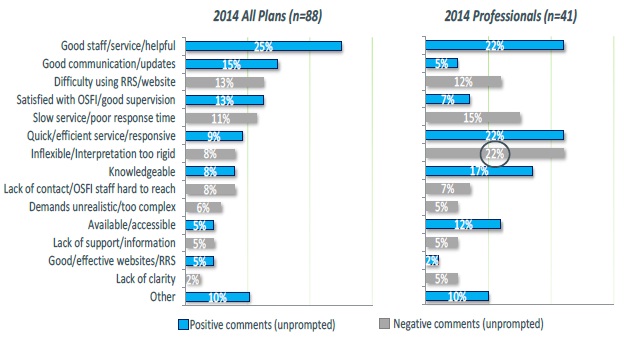
BASE: All valid responses (n=129)
Q2b: Please provide any comments on why you are satisfied/dissatisfied with OSFI as a regulator and supervisor of private pension plans.
There is a widely held belief that OSFI focuses on the appropriate areas of risk affecting pension plans. Eighty-four percent of plan administrators believe OSFI is doing a very good or good job in this area and no plan administrators think OSFI is performing poorly in this area.
Slightly fewer professionals (77%) agree that OSFI is doing a very good or good job focusing on the appropriate areas of risk.
Graph 3 – OSFI's Focus on Appropriate Areas of Risk – Comparison between Plan Administrators and Professionals
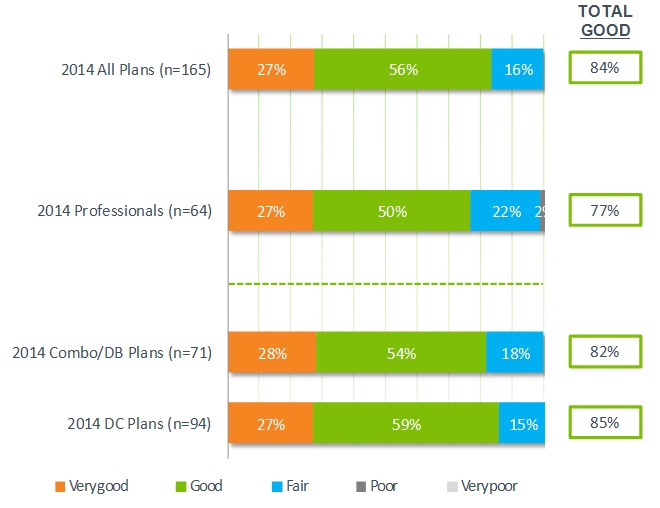
BASE: All valid responses (n=229)
Q3: How would you rate OSFI on the extent to which OSFI focuses on the appropriate areas of risk affecting pension plans?
In terms of risk areas that OSFI should focus on over the next couple of years, monitoring investments (29%) and funding and solvency issues (29%) are the two main risk areas that pension plan administrators identify. These were the main risk areas identified in the 2011 survey as well.
Professionals provide similar unprompted suggestions (28% and 19%, respectively).
Graph 4 – Priority Risk Areas – Comparison between Plan Administrators and Professionals (unprompted suggestions)
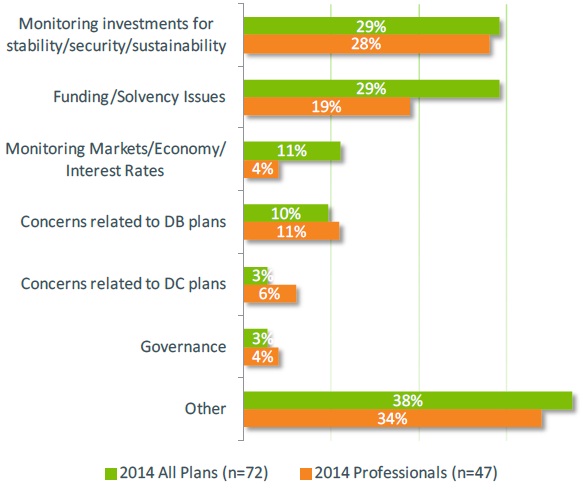
Base: All valid responses (n=119)
Q4: What one or two risk areas do you believe should be priorities for OSFI in the next couple of years pertaining to pension plans?
The majority of respondents continue to have a positive view of OSFI's performance regarding consulting with the pension plan industry when developing guidance. Sixty-nine percent of plan administrators and professionals believe that OSFI is doing a good or very good job; this is in line with the rating provided in 2011 and continues to be higher than the rating provided in 2008.
Smaller plans with less than 50 members are more likely to say that OSFI is doing a good or very good job of consulting with the pension industry (80%) compared to larger plans with more than 50 members (64%).
There is also some difference in opinion by language. French respondents are more likely to give more positive ratings than English respondents, with 85% of French respondents providing a rating of good or very good compared to 67% of English respondents.
Graph 5 – Ratings for Consulting with Industry – Comparison between Plan Administrators and Professionals
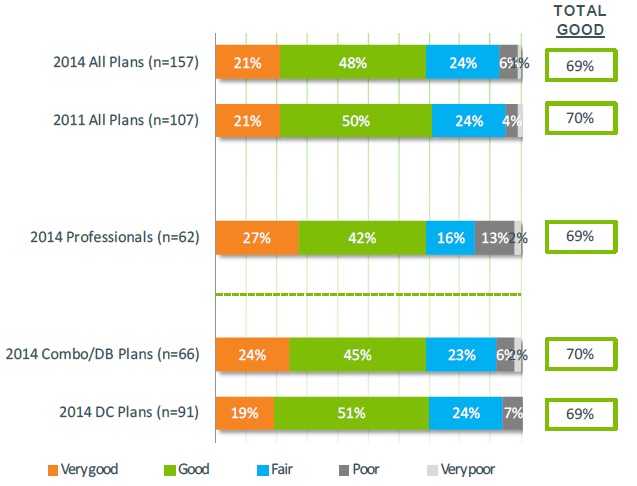
Base: All valid responses (n=219)
Q5: From time to time, OSFI develops guidance (which includes guides, guidelines and instructions) for federally regulated private pension plans. How would you rate OSFI with respect to: Consulting with the pension plan industry when developing guidance?
There continues to be a strong sense among a majority of plan administrators (78%) that OSFI's guidance is very (30%) or somewhat (48%) effective in providing a clear indication of its expectations. This remains consistent since 2008.
Similarly, four in five (82%) professionals provide positive ratings regarding effectiveness on this measure, including one in five (21%) who rate it as very effective.
Plan administrators (30%) are slightly more likely than professionals (21%) to rate OSFI's guidance as very effective in providing a clear indication of its expectations, though the difference is not statistically significant.
Graph 6 – OSFI's Guidance in Providing a Clear Indication of Expectations – Comparison between Plan Administrators and Professionals
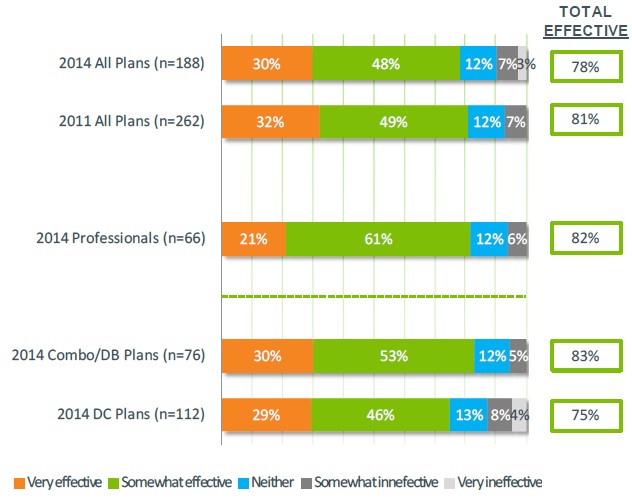
Base: All valid responses (n=254)
Q8: Overall, how effective or ineffective do you think OSFI's guidance is in: Providing a clear indication of OSFI's expectations?
A majority of respondents feel OSFI's guidance supports them in ensuring their plan is compliant with federal pension requirements. Three in four plan administrators (73%) believe OSFI's guidance is effective (very or somewhat) on this measure, including 30% who say very effective.
Similarly, 77% of professionals believe OSFI's guidance is effective on this measure, including 20% who say very effective. Though not statistically significant, slightly more plan administrators (30%) than professionals (20%) rate OSFI's guidance as very effective regarding compliance support.
Again, opinion varies somewhat by language. French respondents (86%) are more likely to indicate OSFI guidance is effective at supporting them in their role compared to English respondents (72%).
Graph 7 – OSFI’s Guidance in Supporting Plan Compliance – Comparison between Plan Administrators and Professionals
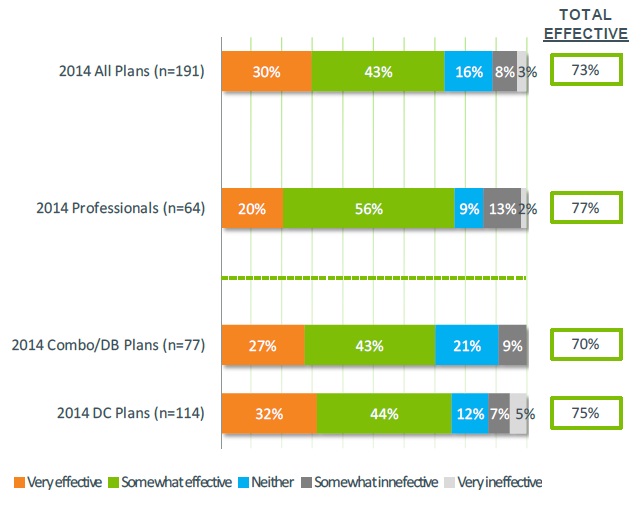
Base: All valid responses (n=255)
Q9: Overall, how effective or ineffective do you think OSFI's guidance is in: Supporting you in your role to ensure that your plan is in compliance with federal pension requirements?
A majority of plan administrators (77%) and professionals (84%) agree they are aware of OSFI's guidance material. Professionals are more likely than plan administrators to strongly agree that they are aware of the materials (47% vs. 19%, respectively).
Among plan administrators, combination/defined benefit plan administrators (84%) are more likely than defined contribution plan administrators (71%) to say they are aware of the guidance material.
Graph 8 – Awareness of OSFI's Guidance Material – Comparison between Plan Administrators and Professionals
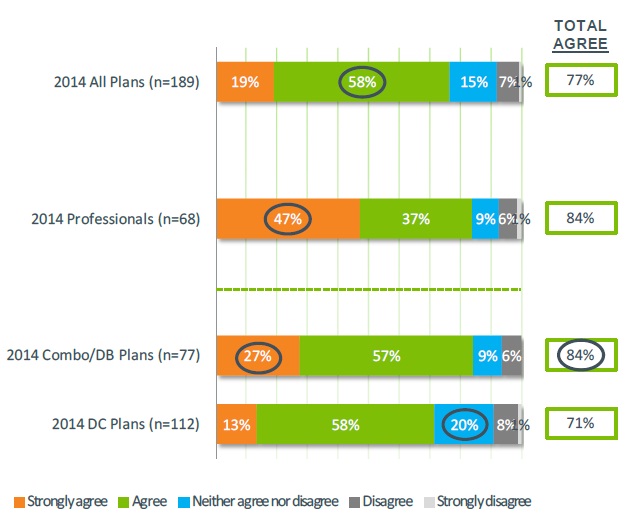
Base: All valid responses (n=257)
Q6: Thinking about OSFI's guidance, would you agree or disagree with the following: I am aware of the guidance material published by OSFI.
When asked whether they know where to find OSFI guidance material, three in four (75%) plan administrators indicate that they know where this information can be found. A similar proportion of professionals (76%) say they know where to find OSFI's guidance material.
Professionals (41%) are more likely than plan administrators (21%) to strongly agree rather than agree (35% and 54%, respectively) that they know where OSFI's guidance material may be found.
Graph 9 – Knowledge of Where to Find Guidance Material – Comparison between Plan Administrators and Professionals
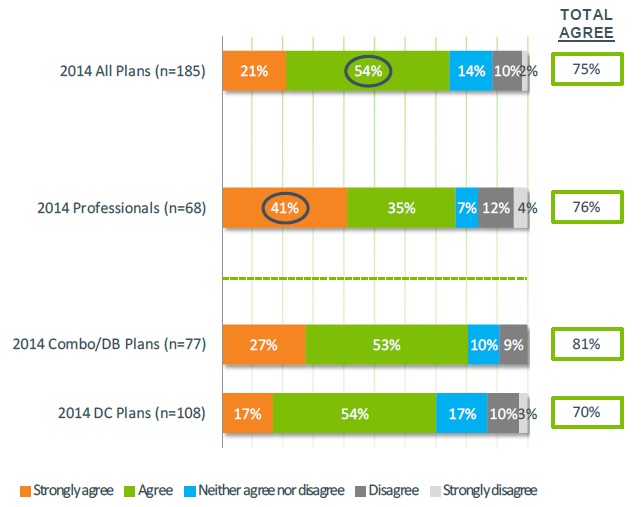
Base: All valid responses (n=253)
Q7: Thinking about OSFI's guidance, would you agree or disagree with the following: I know where to find OSFI guidance material.
The 2014 Pension Plans Survey explored new wording for two questions related to supervision. In both cases, the wording change was implemented to better reflect OSFI's role and to provide further clarity to the question being measured.
A split sampling approach was used to ensure that direct comparisons could be made to previous years' results. As well, it highlights the impact of changing the term used in the survey for future studies.1
The following summarizes the wording changes made to the two questions:
In both lines of questioning some differences exist between the results from the original and revised wording.
When removing the term "monitoring" and elaborating on supervisory activities, there appears to be less inclination among respondents to provide the highest rating possible (very effective) though the total effective rating (very and somewhat effective) is similar between the two wording versions.
When removing the word "actual" and focusing on potential problems, the revised wording version shows a lower total effective score than that of the original wording.
This report includes a discussion of the results using the revised question wording.
Overall, plan administrators continue to have positive impressions of OSFI's effectiveness in supervising plans. Indeed, 81% of plan administrators say OSFI is very (31%) or somewhat (50%) effective in performing this role. Ratings of effectiveness are in line with 2011 (86%).
Plan administrators (81%) rate OSFI slightly higher on this measure than professionals (67%), though the difference is not statistically significant. However, differences between plan administrators and professionals are seen among those who responded very effective (31% vs. 9%, respectively) and neither effective nor ineffective (10% vs. 27%, respectively).
Graph 10 – OSFI's Effectiveness in Supervising Plans – Comparison between Plan Administrators and Professionals
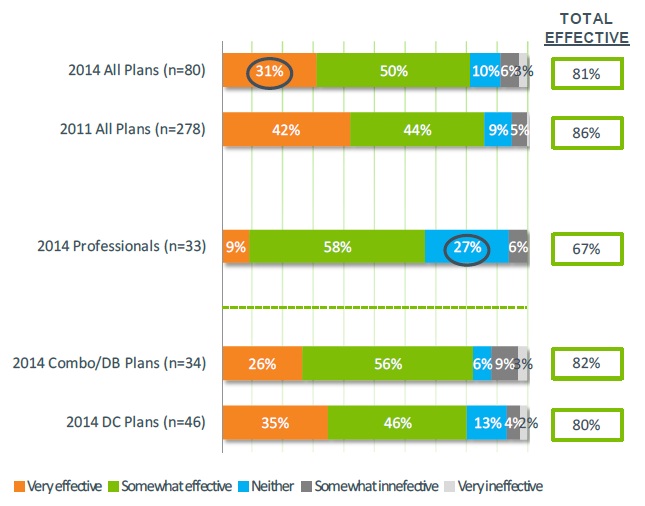
Base: All valid responses (n=113)
Q13: Overall, how effective or ineffective do you think OSFI is in supervising your plan(s) (e.g., ongoing monitoring, on-site examinations and specific interventions)?
The perception that OSFI is effective in identifying potential problems in pension plans remains relatively high in 2014. Seventy-three percent of plan administrators say OSFI is very effective (24%) or somewhat effective (49%) in identifying potential problems.
This is a similar proportion to the 2011 total effective rating (81%). Though the difference is not statistically significant, both professionals and plan administrators are slightly less likely to provide a rating of very effective in 2014 when compared to 2011.
Plan administrators (73%) are more likely to rate OSFI as very effective on this measure when compared to professionals (60%). This could be a result of more professionals (37%) providing a neutral rating when compared to plan administrators (18%).
Graph 11 – OSFI's Effectiveness in Identifying Problems – Comparison between Plan Administrators and Professionals

Base: All valid responses (n=114)
Q10: How effective or ineffective do you believe OSFI is in identifying potential problems in pension plans?
Perceptions of the clarity of OSFI's written correspondence outlining issues of concern are unchanged from 2011. In 2014, 70% of plan administrators consider the clarity of OSFI's written correspondence to be good (23%) or very good (46%). The total "good" rating remains consistent since 2008. However, the proportion of those who feel that the clarity of OSFI's written correspondence is very good has improved (23%, 26% and 15% in 2014, 2011 and 2008, respectively).
Ratings from professionals (69%) are similar to plan administrators overall. Among plan administrators, there are differences between defined benefit/combination plan administrators and defined contribution plan administrators who provide ratings of very good (31% and 18%, respectively) and poor (3% and 11%, respectively).
Graph 12 – Clarity of OSFI's Written Correspondence – Comparison between Plan Administrators and Professionals
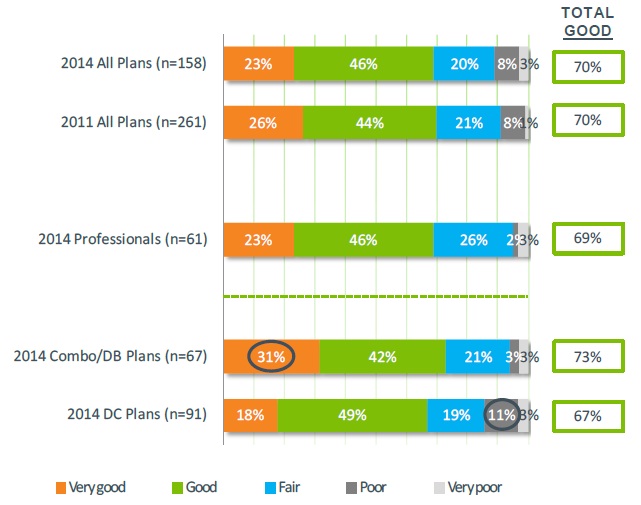
Base: All valid responses (n=219)
Q12: Thinking back over the past year, how would you rate OSFI with respect to: The clarity of OSFI's written correspondence outlining issues of concern?
Survey participants believe OSFI is performing well at providing opportunities to discuss issues of concern prior to coming to a conclusion. Sixty-four percent of plan administrators rate OSFI as at least good in 2014, including 27% who say it is very good. This measure has improved incrementally since 2008 (59% and 53% in 2011 and 2008, respectively).
Though not statistically significant, professionals (75%) provide slightly higher ratings than plan administrators overall (64%).
Among plan administrators, defined contribution plans are less likely to provide a very good rating (16%) compared to defined benefit/combination plan administrators (40%), but more likely to provide a good rating (47% vs. 24%, respectively).
Graph 13 – Providing Opportunities to Discuss Issues – Comparison between Plan Administrators and Professionals
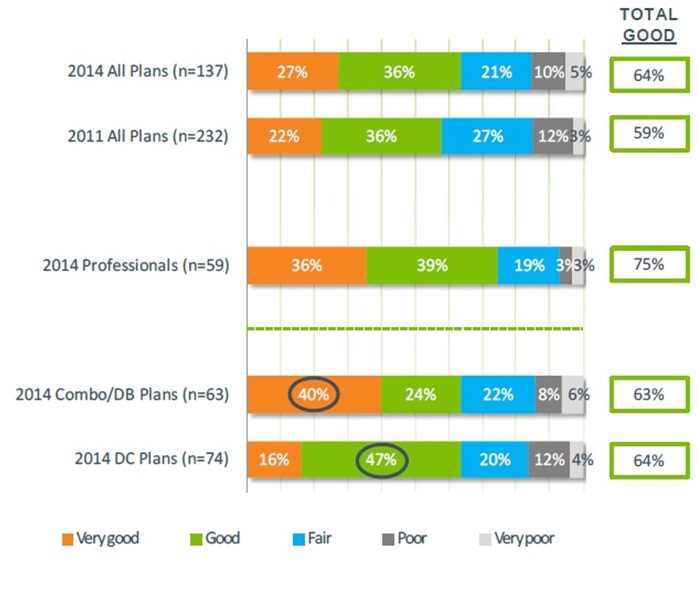
Base: All valid responses (n=196)
Q11: Thinking back over the past year, how would you rate OSFI with respect to: Providing an opportunity for your plan(s) to discuss issues of concern with OSFI prior to OSFI coming to a conclusion?
Respondents were asked about their experience and satisfaction with the approvals process.
Only a minority (38%) of plan administrators submitted an application for regulatory approval in the past 3 years. Professionals (58%) are more likely than plan administrators to have done so.
Graph 14 – Respondents that Have Submitted Application for Approval – Comparison between Plan Administrators and Professionals
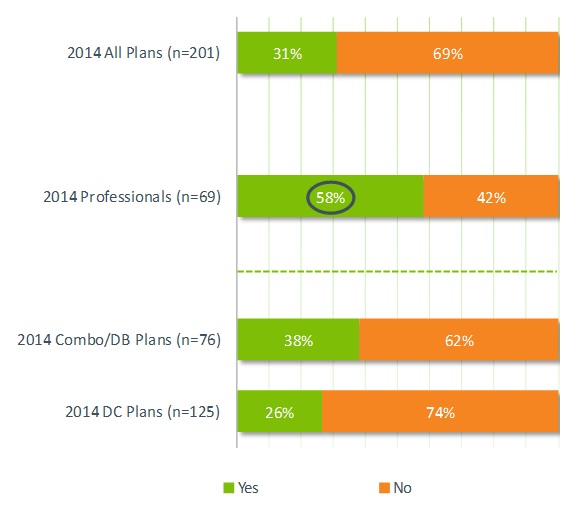
Base: All valid responses (n=270)
Q14: Have you submitted an application for a regulatory approval in the past 3 years?
In 2014, only those who submitted an application for approval responded to survey questions regarding satisfaction with various aspects of the process. As this was a slight change in methodology from the 2011 Pension Plans Survey, the 2011 data has been recalculated to allow for a direct comparison to the 2014 results.
Overall satisfaction with the processing of applications is relatively unchanged. Three in four (75%) plan administrators are satisfied (very or somewhat) in 2014 while it was 81% in 2011; satisfaction among professionals is also high at 72%.
Plan administrators (38%) are slightly more likely than professionals (21%) to provide a rating of "very satisfied" though this difference is not statistically significant.
Graph 15 – Satisfaction with OSFI in Processing Applications – Comparison between Plan Administrators and Professionals
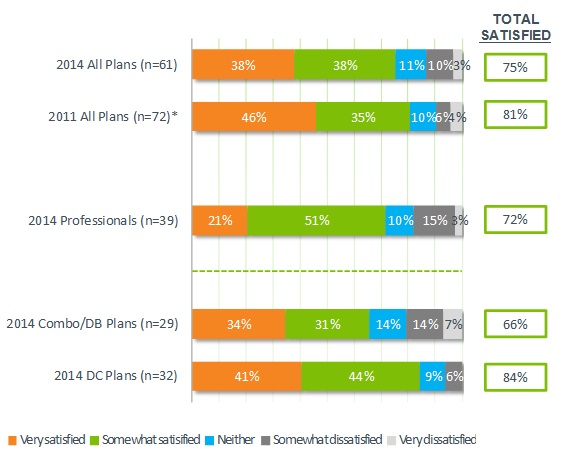
Base: Valid responses among those who have submitted an application for regulatory approval in the last 3 years (n=100)
Caution: subgroups have small base sizes.
Q15: What is your overall level of satisfaction with OSFI in processing applications from your plan(s)?
Similar to 2011 results, there continues to be a relatively high degree of satisfaction with OSFI regarding the timeliness of processing requests for approvals. Seven in ten (69%) plan administrators are either very (27%) or somewhat (42%) satisfied with the processing time. A similar percentage (60%) of professionals are also very (15%) or somewhat (45%) satisfied.
Defined benefit/combination plan administrators (55%) are the least likely to be satisfied with the processing time and give ratings far below those of defined contribution plans (83%).
Graph 16 – Satisfaction with OSFI in Timeliness of Processing Requests – Comparison between Plan Administrators and Professionals
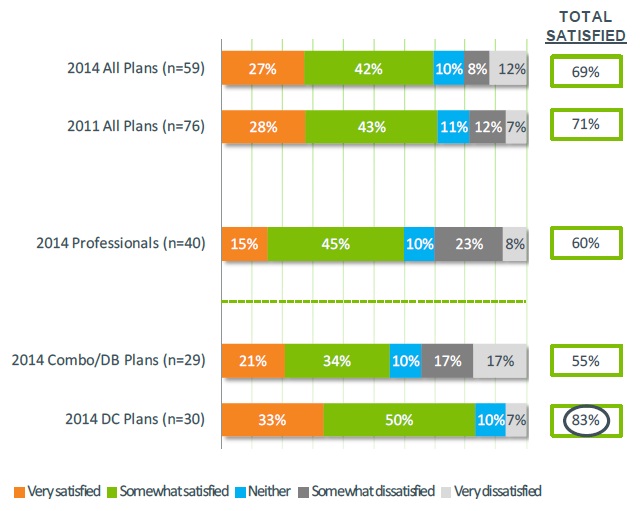
Base: Valid responses among those who have submitted an application for regulatory approval in the last 3 years (n=99)
Caution: subgroups have small base sizes.
Q18: How satisfied or dissatisfied are you with the timeliness with which OSFI processes application(s) for approval from your plan(s)?
A majority of plan administrators feel they can discuss concerns related to approvals with OSFI prior to OSFI coming to a conclusion. Overall, 73% of plan administrators rate OSFI as very good or good on this measure, which has increased slightly since 2011 (61%) and significantly since 2008 (53%).
Having said that, slightly fewer combination/defined benefit plan administrators provide a good rating (66%) when compared to defined contribution plans (81%) and professionals (78%); this difference is not statistically significant.
Graph 17 – Opportunity to Discuss Issues of Concern – Comparison between Plan Administrators and Professionals
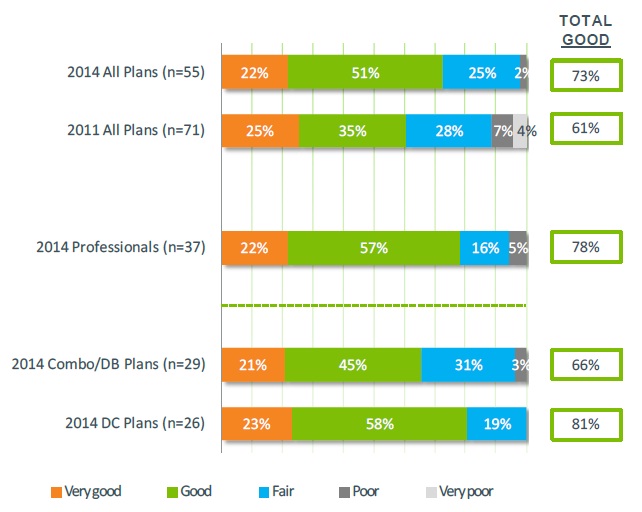
Base: Valid responses among those who have submitted an application for regulatory approval in the last 3 years (n=92)
Caution: subgroups have small base sizes.
Q17: Thinking about application(s) for a regulatory approval your pension plan submitted in the past 3 years, how would you rate OSFI with respect to: Providing an opportunity to discuss issues of concern with OSFI prior to OSFI coming to a conclusion.
A majority have positive views of OSFI's responsiveness to requests for updates on the status of applications submitted for approval. Seventy-seven percent of plan administrators feel that OSFI's performance is very good or good.
About six in ten (63%) professionals provide a similarly good rating.
Defined contribution plan administrators are particularly satisfied on this measure (93%) and do not provide any negative ratings.
Graph 18 – Responsiveness to Application Status Updates – Comparison between Plan Administrators and Professionals
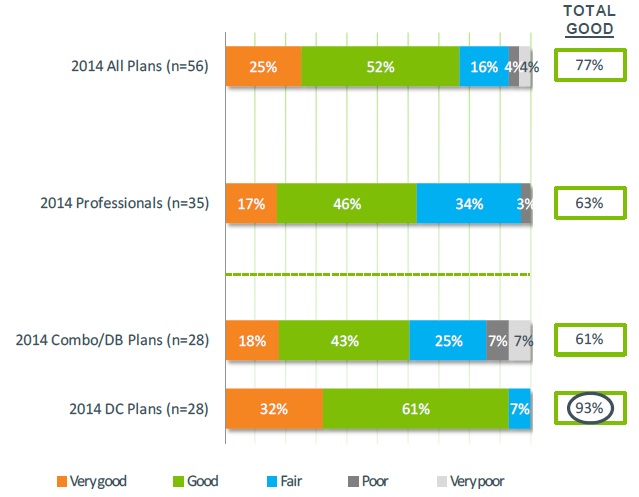
Base: Valid responses among those who have submitted an application for regulatory approval in the last 3 years (n=91)
Caution: subgroups have small base sizes.
Q16: Thinking about application(s) for a regulatory approval your pension plan submitted in the past 3 years, how would you rate OSFI with respect to: Responding to requests for updates on the status of applications submitted by your pension plan(s)?
The Relationship Manager or Plan Supervisor (43%) is the most common point of contact when plan administrators have questions related to the private pension plans in which they play a role. This is followed closely by using OSFI's 1-800 toll free line (23%).
A similar percentage (38%) of professionals contact the Relationship Manager, though fewer have tried the 1-800 number (7%) and more will contact an actuarial consultant (29% vs. 6% of plan administrators).
Defined contribution plan administrators are more likely than defined benefit/combination plan administrators to try the 1-800 number (34% vs. 6%, respectively) and less likely to contact their Relationship Manager (26% vs. 69%, respectively).
Graph 19 – Main Contact for Questions – Comparison between Plan Administrators and Professionals

Base: All valid responses (n=214)
Q19: When you have a question related to the private pension plan(s) for which you play a role, who do you normally contact at OSFI?
When asked for an indication of the main reason plan administrators most recently contacted OSFI, the most frequently provided answer relates to assistance in filling out forms, including filing returns with RRS (50%). This is particularly true for defined contribution plans (63%).
Professionals are less likely to contact OSFI for help with filling out forms (12%), but more likely to request assistance regarding the interpretation of legislation (45%).
Graph 20 – Main Reasons for Contacting OSFI – Comparison between Plan Administrators and Professionals
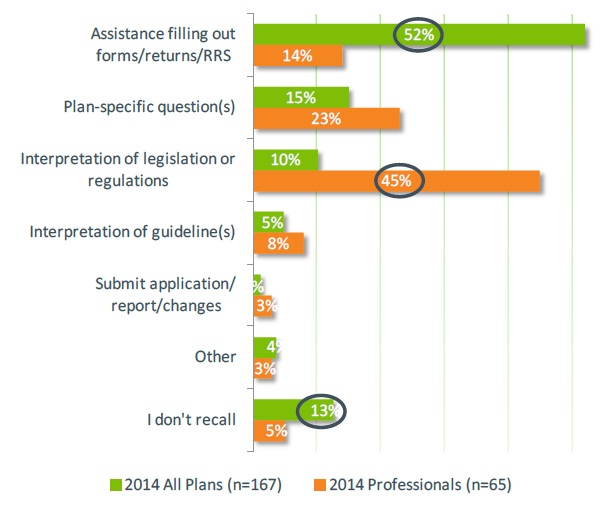
Base: All valid responses (n=232)
Q23: Thinking about your most recent interaction with OSFI, what was the main reason you contacted OSFI?
Regardless of the reason for their most recent interaction with OSFI, the vast majority (91%) of plan administrators indicate that they received the help they needed.
Professionals (81%) are slightly less likely to have received the help they needed, though the difference is not considered statistically significant.
Graph 21 – Received Information/Assistance Requested – Comparison between Plan Administrators and Professionals
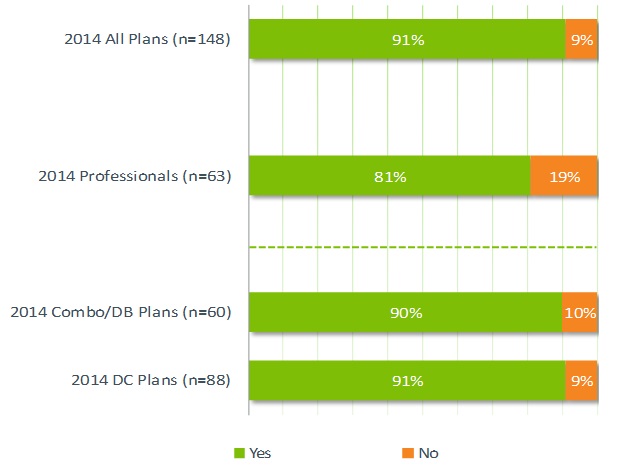
Base: Valid responses among those who had a reason to contact OSFI (n=211)
Q24: In the end, did you get the information/assistance you needed?
Among the very few who indicate they did not receive the information or assistance that they needed, most are likely to say that their request is still in progress.
Table 1 – Information/Assistance Not Received – Comparison between Plan Administrators and Professionals
| Information needed | 2014 All Plans (n=13) |
2014 Professionals (n=8) |
|---|---|---|
| Still in progress/awaiting a response from OSFI | 5 | 2 |
| Poor/unclear information/responses | 2 | --- |
| Lack of knowledge/expertise | 2 | 2 |
| Other | 4 | 4 |
Base: Valid responses among those who did not get the information/assistance they needed (n=21)
Caution: small base sizes.
Q24b: Please tell us what information/assistance you did not receive.
Satisfaction remains quite high regarding OSFI's capacity to interact with plan administrators in the official language of their choice. Eighty-five percent of plan administrators indicate satisfaction with OSFI which is in line with 2011 (88%).
Eighty-nine percent of professionals report satisfaction with OSFI on this measure; no professionals report being dissatisfied.
Of the handful of respondents who indicated dissatisfaction, 3 were English and 1 was French.
Graph 22 – Satisfaction of Interaction in Language of Choice – Comparison between Plan Administrators and Professionals
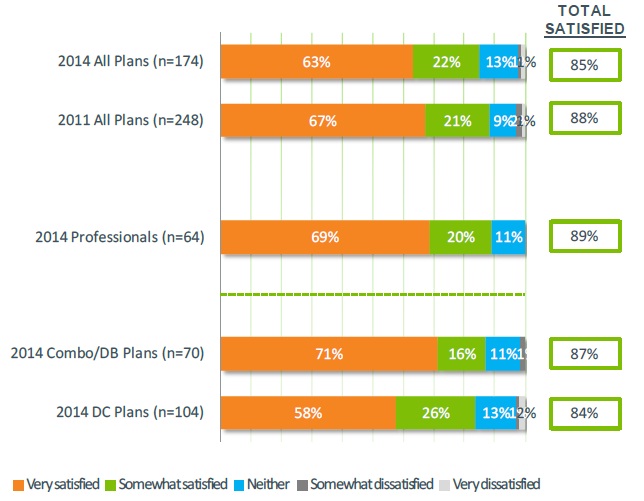
Base: Valid responses (n=238)
English responses (n=203)
French responses (n=35)
Q21: Thinking about your interactions with OSFI staff on any pension supervisory or regulatory matter, overall how satisfied or dissatisfied are you with: OSFI's capacity to interact with you in the official language of your choice (i.e., English or French)?
Satisfaction among plan administrators with the timeliness of OSFI's response to general and plan-specific related enquiries is relatively high at 69%, including 32% who are very satisfied.
Professionals (64%) provide similar satisfaction ratings, but are slightly less likely to provide ratings of very satisfied (23%) (though the difference is not statistically significant).
Graph 23 – Satisfaction with Timeliness of Response to Enquiries – Comparison between Plan Administrators and Professionals
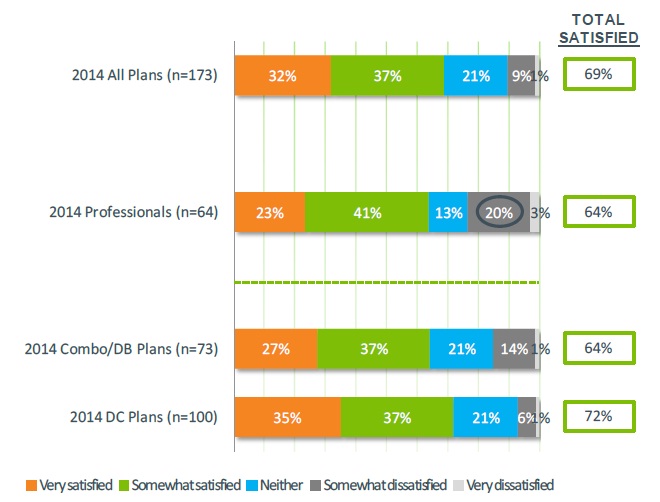
Base: All valid responses (n=237)
Q20: Thinking about your interactions with OSFI staff on any pension supervisory or regulatory matter, overall how satisfied or dissatisfied are you with: the timeliness of OSFI's response to general and plan-specific related enquiries?
About half of the plan administrators (52%) that responded to this survey claim they would participate in the next OSFI-hosted pension industry forum. Fifty-two percent would participate, 17% would not and 32% are still undecided.
Combination/defined benefit plans (62%) are more likely than defined contribution plans (45%) to expect that they will participate.
Professionals (68%) are more likely than plan administrators to expect that they would participate.
Graph 24 – Participation in Future Forums – Comparison between Plan Administrators and Professionals
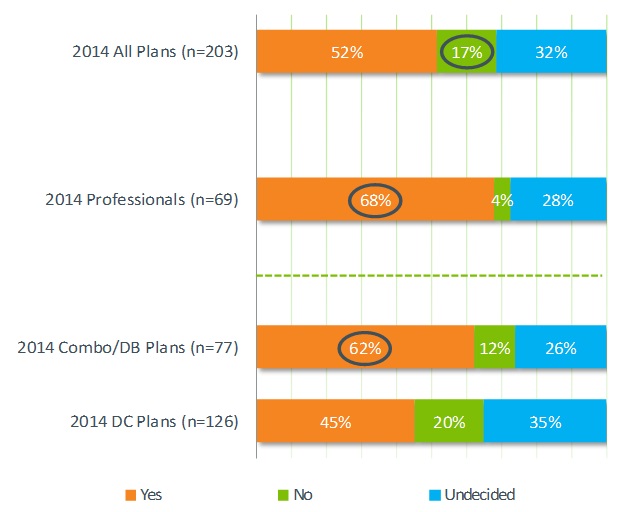
Base: All valid responses (n=272)
Q25: Going forward, if OSFI holds the Pension Industry Forum via webinar only, would you plan to participate?
Among plan administrators who do not plan to participate in the next pension industry forum, most indicate it is because they are unsure of whether they will be available (51%). One in five (21%) plan administrators are not interested in participating in future forums, while a few (11%) would prefer an in-person forum.
Similar percentages of professionals say they are unsure of their availability (55%), are not interested in participating (14%) or would prefer an in-person forum (23%). Though these percentages may appear different compared to plan administrators, the differences are not statistically significant.
Graph 25 – Main Reason for Not Participating in Forum – Comparison between Plan Administrators and Professionals
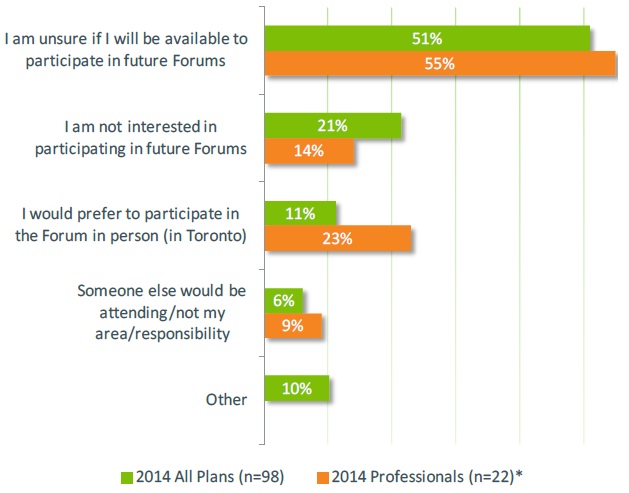
Base: All valid responses among those who would not plan to participate in the webinar (n=120)
*Caution: small base size
Q25b: Please select the main reason you would not plan to participate?
The majority of survey participants are still not aware of OSFI's electronic newsletter, InfoPensions, a trend that has been consistent since 2008.
Overall awareness (aware and read all/some/none) among plan administrators remains relatively low at 46%. Thirty percent of plan administrators have read InfoPensions, which is the same percentage as in 2011 (30%) and similar to 2008 (28%).
Defined contribution plan administrators (38%) have the lowest awareness while professionals (74%) have the highest awareness. Defined contribution plan administrators (20%) are the least likely to have read InfoPensions while professionals are the most likely (52%).
Graph 26 – Awareness and Usage of InfoPensions – Comparison between Plan Administrators and Professionals
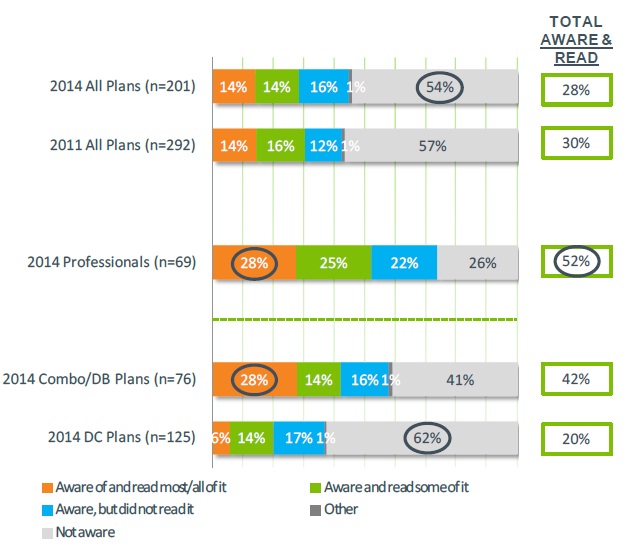
Base: All valid responses (n=270)
Q26: In November 2014, the most recent edition of OSFI's electronic newsletter "InfoPensions" (Issue 12) was posted on its website. Thinking about this recent InfoPensions, were you: [...]
All of those that have read InfoPensions rate it as useful on some level. Ratings were provided on a scale of 1 to 5 where 5 is very useful and 1 is not at all useful. Seventy-three percent of plan administrators who have read the newsletter generally find it useful (rating of 4 or 5), which is in line with 2011 (68%) and 2008 (78%).
Professionals (83%) and defined benefit/ combination plan administrators (82%) are most likely to find the publication useful.
Graph 27 – Usefulness of the Information in InfoPensions – Comparison between Plan Administrators and Professionals
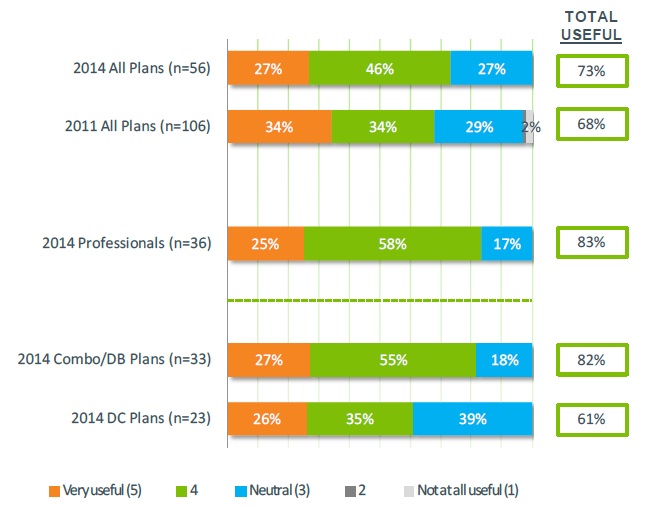
Base: Valid responses among those who are aware of InfoPensions (n=92)
Caution: subgroups have small base sizes.
Q27: How would you rate the usefulness of the information provided in the November 2014 InfoPensions (Issue 12)?
In 2014, more respondents state that they are using the Pensions area of OSFI's website, though usage remains infrequent.
More plan administrators have moved from not visiting the website at all (16%) to visiting it less than once every three months (54%). This is compared to 31% and 39% in 2011, respectively. This trend is observed most greatly among defined benefit/combination plan administrators (22% and 61%, respectively).
Professionals (32%) are more likely to report high frequency of usage than plan administrators (5%).
Graph 28 – Frequency of Visiting Private Pension Plans Area of Website – Comparison between Plan Administrators and Professionals
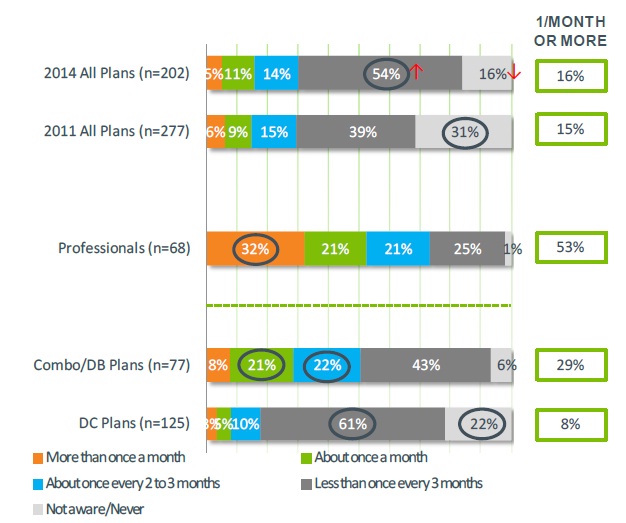
Base: All valid responses (n=270)
Q28: How often do you typically visit the Private Pension Plans area of OSFI's website?
Fewer respondents indicate the information found in the Pensions area of the website is useful (ratings were provided on a scale of 1 to 5, where 5 is very useful and 1 is not at all useful).
Only 57% of plan administrators find the information in the Pensions area of the website to be useful compared to 70% in 2011. Additionally, a 12-point increase is seen among those providing a neutral rating.
Professionals (73%) are more likely than plan administrators to find the information on the website useful.
Combination/defined benefit plans (66%) are more likely than defined contribution plans (49%) to find the information useful.
French respondents are also more likely to find the website information useful (85% useful) compared to English respondents (57% useful).
Graph 29 – Perception of Usefulness of Information in Pensions Area of Website – Comparison between Plan Administrators and Professionals
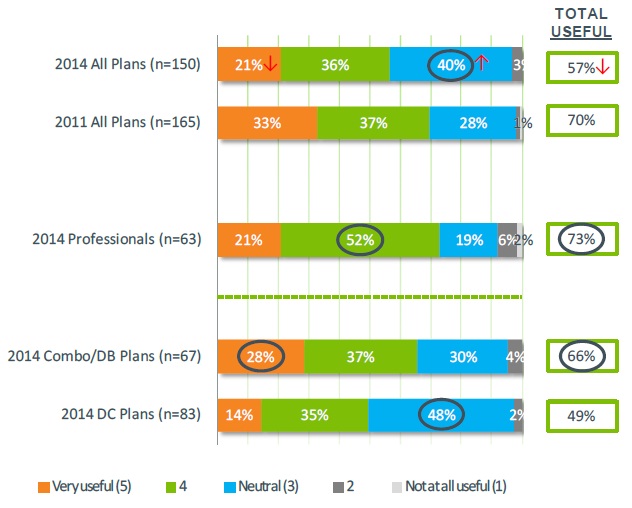
Base: Valid responses among those who have visited the OSFI website (n=213)
Q29: Overall, how would you rate the usefulness of the information provided in the Private Pension Plans area of OSFI's website?
About half (42%) of plan administrators have visited the Private Pension Plans area of the OSFI website to obtain information on filing returns using the new Regulatory Reporting System (RRS) or for reporting requirements.
Fewer professionals have visited the website for filing returns using the RRS (22%) and even less so for reporting requirements (13%). Instead, professionals are more likely to go to OSFI's website for updates on guidance (67%) or to research specific topics (51%).
Graph 30 – Main Purpose of Visit to Pension Website – Comparison between Plan Administrators and Professionals
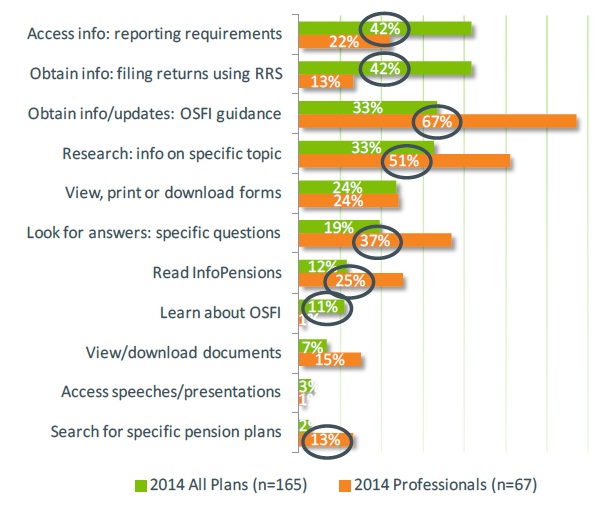
Base: Valid responses among those who have visited the OSFI website (n=232)
Q30: Thinking about your visit(s) over the past year to the Private Pension Plans area of OSFI's website, what was the main purpose(s) of your visit?
The majority of plan administrators indicate they can find all of the information they are looking for on OSFI's website if it relates to printing forms, or most of what they are looking for related to updates, reporting requirements, or specific information.
Most professionals can also find all of what they are looking for when it relates to InfoPensions or printing forms, and most of what they are looking for regarding information on guidance or specific questions.
Plan administrators indicate that they have trouble finding information on the website related to RRS with 21% finding some and 17% finding a little or no information.
Table 2 – Information Found on the OSFI Website – Comparison between Plan Administrators and Professionals
| All Plans | All | Most | Some | A little | None |
|---|---|---|---|---|---|
| View/print forms (n=39) | 62% | 26% | 13% | --- | --- |
| Obtain information on updates on OSFI guidance (n=53) | 28% | 49% | 19% | 4% | --- |
| Information related to reporting requirements (n=68) | 28% | 47% | 21% | 3% | 1% |
| Information on filing returns using RRS (n=66) | 27% | 35% | 21% | 14% | 3% |
| Research information on a specific topic (n=50) | 18% | 48% | 26% | 6% | 2% |
| Professionals | All | Most | Some | A little | None |
| Read InfoPensions (n=17) | 59% | 41% | --- | --- | --- |
| View/print forms (n=16) | 56% | 38% | --- | --- | 6% |
| Obtain information on updates on OSFI guidance (n=43) | 26% | 44% | 21% | 9% | --- |
| Research information on a specific topic (n=34) | 9% | 56% | 24% | 9% | 3% |
| Look for answers to specific questions (n=17) | 4% | 42% | 29% | 17% | 8% |
Base: Valid responses among those who have visited the OSFI website (base sizes vary)
Caution: Some attributes have small base sizes.
Q31: Would you say you found….?
Among the relatively small number of respondents that had difficulty finding the information they needed on the OSFI website, the most common issue identified was they could not find anything related to RRS guidance/troubleshooting.
Table 3 – Information Not Found on the OSFI Website – Comparison between Plan Administrators and Professionals
| 2014 All Plans (n=24) |
2014 Professionals (n=16) |
|
|---|---|---|
| RRS information/guidance/troubleshooting | 9 | 1 |
| Clear instructions/directions on filing/completing forms/submitting reports | 4 | --- |
| Pension information/guides | 4 | 1 |
| Difficulty finding/location forms (unspecified) | 1 | 2 |
| Interpretation/more complete/expanded interpretive bulletins | 1 | 1 |
| Answers to specific questions | --- | 4 |
| Other | 5 | 7 |
Base: Valid responses among Plan Administrators who were not able to find all or most of what they needed on OSFI's website (n=40)
Caution: Small base sizes.
Q31b: Please describe what you did not find on the OSFI website.
A majority of plan administrators (77%) indicate they have used OSFI's new Regulatory Reporting System (RRS), while professionals (45%) are less likely to be RRS users.
Graph 31 – Users of the Regulatory Reporting System – Comparison between Plan Administrators and Professionals
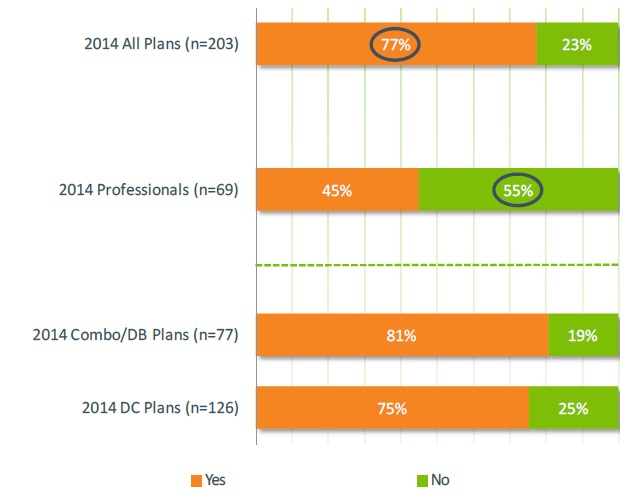
Base: All valid responses (n=272)
Q32: Are you a user of the Regulatory Reporting System (RRS)?
Only users of the RRS were asked to respond to other questions related to the RRS.
Among the plan administrators that are RRS users, three-quarters (75%) have also used the RRS training materials.
A similar percentage of professionals (68%) have also used the RRS training materials.
Graph 32 – Users of the Regulatory Reporting System Training Materials – Comparison between Plan Administrators and Professionals
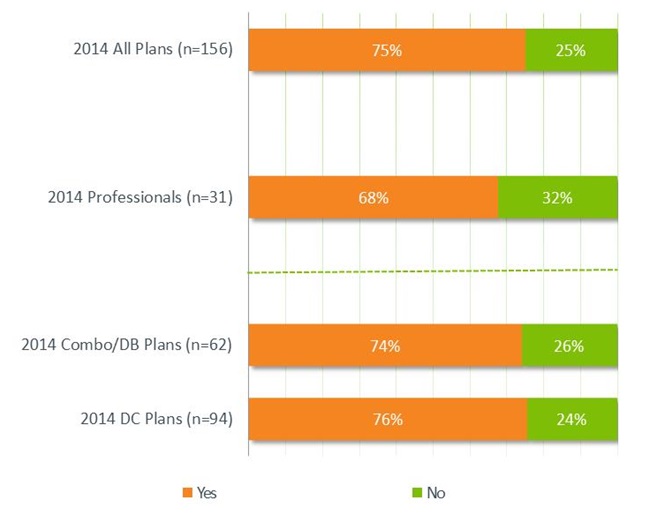
Base: Valid responses among RRS users (n=187)
Q33: Have you used the training materials for RRS users?
Of the plan administrators that have not used the RRS training materials, 16 were not aware that RRS training materials were available and another 8 feel that they do not need RRS training.
Table 4 – Reasons for Not Using Training Materials – Comparison between Plan Administrators and Professionals
| 2014 All Plans (n=39) |
2014 Professionals (n=10) |
|
|---|---|---|
| I was not aware that RRS training materials were available. | 16 | 2 |
| I do not need RRS training. | 8 | 5 |
| Someone else prepares/inputs data/I play a limited role | 7 | 2 |
| Busy/no time | 3 | 0 |
| Other | 3 | 0 |
Base: Valid responses among RRS users who have not used RRS training materials (n=49)
Caution: small base sizes.
Q33b: Please tell us why you have not used the RRS training materials.
About half (47%) of the plan administrators that have used the RRS training materials indicate that they were easy to use.
Slightly fewer professionals (29%) found the materials easy to use. Due to the small sample size of professionals, this difference is not statistically significant.
Graph 33 – Ease of Use of Regulatory Reporting System Training Materials – Comparison between Plan Administrators and Professionals
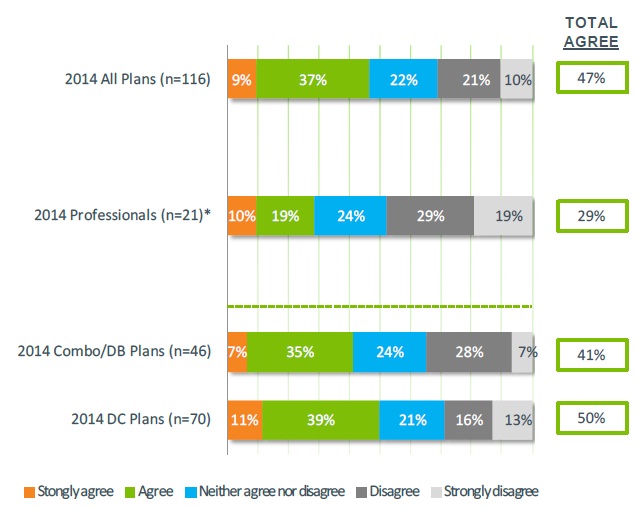
Base: Valid responses among RRS users who have used RRS training materials (n=137)
* Caution: small base sizes.
Q34: Do you agree or disagree that the training materials for RRS users are easy to use (e.g., web tutorials, user guides, quick reference guides)?
Respondents that found the RRS training materials difficult to use were asked a follow-up question to help understand why that was the case. The most common issue identified is that the materials are hard to understand and very technical.
Other reasons provided relate to the comprehensiveness of the documents and that they are not user friendly.
Table 5 – Reasons the Regulatory Reporting System Training Materials are Not Easy to Use – Comparison between Plan Administrators and Professionals
| 2014 All Plans (n=30*) |
2014 Professionals (n=10*) |
|
|---|---|---|
| Hard to understand/too technical/confusing | 13 | 5 |
| Did not provide sufficient information/did not address issues | 9 | 3 |
| Hard to use/not user friendly | 7 | 3 |
| Documentation/manual too lengthy | 6 | 0 |
| Lack of help resources | 2 | 2 |
| Hard to navigate/poor layout/information hard to find | 2 | 1 |
| Other | 5 | 1 |
Base: Valid responses among RRS users who have used RRS training materials, but did not find them easy to use (n=40) *Note: Respondents could provide multiple responses.
Caution: small base sizes.
Q34b: Please explain why you did not find the RRS training materials easy to use.
Most survey respondents continue to feel that OSFI is proactive in dealing with emerging issues. Seventy percent of plan administrators say that OSFI is either very good (19%) or good (51%) at being proactive, which is in line with 2011 (64%) and remains higher than 2008 (54%).
Sixty-seven percent of professionals provide positive ratings of OSFI on this measure.
Graph 34 – OSFI's Proactive Ability to Deal with Emerging Issues – Comparison between Plan Administrators and Professionals
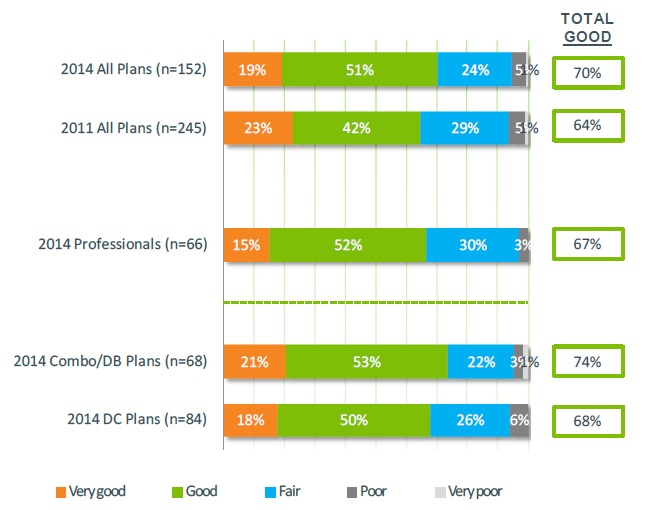
Base: All valid responses (n=218)
Q35: How would you rate OSFI with respect to how proactive it is in dealing with emerging issues pertaining to pension plans?
The last survey question offered participants the opportunity to provide additional comments about the topics raised, as well as to identify any other relevant issues.
As table 6 indicates, the primary issue raised relates to difficulties in using the RRS and OSFI's website. This was raised by both plan administrators and professionals.
Table 6 – Final Comments – Comparison between Plan Administrators and Professionals
| 2014 All Plans (n=52*) |
2014 Professionals (n=19*) |
|
|---|---|---|
| Difficulty using RRS/Website | 17 | 6 |
| OSFI needs to provide better support | 4 | 1 |
| Good staff/service/helpful | 1 | 4 |
| Lack of contact/OSFI staff hard to reach | 3 | 1 |
| Slow service/poor response time | 3 | 1 |
| Demands unrealistic/too complex | 2 | 1 |
| Inflexible/Interpretation too rigid | 1 | 3 |
| Concerns related to defined benefit (DB) plans | 2 | 1 |
| Satisfied with OSFI/good regulation | 2 | 0 |
| Limited dealings/experiences with OSFI | 2 | 0 |
| Other | 6 | 1 |
| None/no comments | 16 | 1 |
Base: All valid responses (n=71) *Note: Respondents could provide multiple responses.
Caution: small base sizes.
Q36: Are there any other comments you would like to make concerning the issues raised in this questionnaire, or about other issues you believe are relevant at this time?
The same core survey instrument from the 2011 study was used, with some modifications made to update the 2014 Pension Plans Survey. These include: the removal of a few questions, the addition of several new questions, and revisions to a number of questions, for a final survey of 42 questions, 36 of which were scaled questions and 6 open-ended questions. As a result of changes made to the survey, a pre-test was conducted. The results of the pre-test indicated changes to the questionnaire were not problematic. On average, the survey took 16 minutes to complete. The same survey was used for both telephone and online approaches. The final questionnaire is found in the Appendix.
The target population for the 2014 survey was federally regulated private pension plans which are "actively" supervised by OSFI, and with $500,000 in assets or more. OSFI provided Harris/Decima with a password-protected detailed contact list of both professional advisors and pension plan administrators.
After removing duplicate contacts and invalid email addresses there were a total of 918 valid records: 229 professional advisors; and 689 pension plan administrators. All 918 valid contacts were invited to participate in the attempted census survey. Respondents were initially invited to complete the survey online (for which a unique URL link was created to access the survey online), with a round of follow-up reminder telephone calls conducted. During the reminder telephone call, respondents were given the option to complete the survey by phone at that time. Since the entire population of active pension plans (with assets over $500k) regulated by OSFI was invited to participate in this study there is no margin of sampling error to be estimated or reported.
In 2014, a larger sample list of professionals who interact with OSFI on behalf of pension plans was available to draw from. As a result, a larger proportion of surveys were completed among professionals than in the past.
| Number of completions | Response rate | |
|---|---|---|
| Overall response rate | 272 | 30% |
| DB Plan Administrators | 54 | 35% |
| DC Plan Administrators | 126 | 28% |
| Professionals | 69 | 30% |
| Combination Plans | 23 | 28% |
Prior to data collection, a letter from OSFI's Superintendent was sent by OSFI to all eligible participants advising them of the upcoming survey.
Participants were then sent an email that included a unique link to the survey. Harris/Decima was responsible for the production and distribution of the invitation emails. For the invitations sent to participants, please see the Appendix.
A pre-test was held from November 12, 2014 until November 14, 2014. Results of the pre-test indicated changes to the questionnaire were not problematic so the survey was then fully launched on November 17, 2014. The secure survey website was accessible 24 hours a day, seven days a week from any web-enabled computer or mobile device. This allowed plan administrators and professional advisors to complete the survey at their own pace and at a time that was convenient for them. Three reminder emails were sent to respondents who had not yet completed the survey. Reminders were sent at the following intervals:
All three email reminder texts used can be found in the Appendix.
Harris/Decima also conducted follow-up reminder telephone calls from December 1-5, 2014. The purpose of these calls was two-fold: to prompt response, and to answer any questions the potential respondent had.
Potential respondents were difficult to reach via telephone. As a result, Harris/Decima interviewers left messages with a 1-800 number respondents could call back to complete the survey. In addition, if respondents refused to complete the survey over the phone, the option was given to remind respondents to complete the survey online; the email address was confirmed by phone in order to send a unique survey link.
The survey closed on December 15, 2014 with a total of 272 surveys completed, 239 online, and 33 via telephone. Of the total valid sample, the survey yielded a completion rate of 30%. Given the small number of participating Combination plans, their results were merged with DB plans for analysis. A total of 236 surveys were completed in English and 36 in French.
Discussion of Non-Response Bias
In order to investigate whether non-response bias may have had an impact on the results, the demographic characteristics of the respondent profile and sample universe were compared.
Overall, the percentage of plan administrators (75%) and professionals (25%) who completed the survey mimics the sample universe (75% and 25%, respectively).
Among plan administrators, the plan type, size and language is similar to the information profiled in the sample universe. Defined benefit plan administrators were slightly more likely to have completed the survey (27% vs. 22% in the sample universe), but the difference is not statistically significant. By contrast, defined contribution plan administrators were slightly less likely to have completed the survey (62% vs. 66% in the sample universe). Plan administrators with more than 50 active members were slightly more likely (64% vs. 60% in the sample universe) than those with 50 or fewer active members (36% vs. 40% in the sample universe) to have completed the survey. The differences are not statistically significant.
The type of professional responding to the survey is similar to the information profiled in the sample universe. Lawyers are slightly more likely to have completed the survey than other types of professionals, but the difference is not statistically significant (19% vs. 10% in the sample universe).
The following tables provide an overview of the key demographics within the sample file compared to the respondent profile.
Total Sample
| Sample universe | Respondent profile | |||
|---|---|---|---|---|
| Counts | % | Counts | % | |
| Total Sample | 918 | 100% | 272 | 100% |
| Plan Administrators | 689 | 75% | 203 | 75% |
| Professionals | 229 | 25% | 69 | 25% |
Plan Administrators
| Sample universe | Respondent profile | |||
|---|---|---|---|---|
| Counts | % | Counts | % | |
| Total Plan Administrators | 689 | 100% | 203 | 100% |
| Defined benefit plan administrators | 153 | 22% | 54 | 27% |
| Defined contribution plan administrators | 454 | 66% | 126 | 62% |
| Combination plan administrators | 82 | 12% | 23 | 11% |
| Plan Size | 689 | 100% | 203 | 100% |
| 50 or fewer | 276 | 40% | 74 | 36% |
| More than 50 | 413 | 60% | 129 | 64% |
| Language | 689 | 100% | 203 | 100% |
| English | 642 | 93% | 188 | 93% |
| French | 47 | 7% | 15 | 7% |
Professionals
| Sample universe | Respondent profile | |||
|---|---|---|---|---|
| Counts | % | Counts | % | |
| Total Professionals | 229 | 100% | 69 | 100% |
| Actuary/Actuarial Firm | 84 | 37% | 26 | 38% |
| Lawyers | 24 | 10% | 13 | 19% |
| Third party/Third party administrator | 96 | 42% | 30 | 43% |
| Consultant/Consulting Firm/Insurance company/Pension fund custodian/Other | 25 | 11% | 0 | 0% |
Harris/Decima has been retained by the Office of the Superintendent of Financial Institutions (OSFI) to conduct this survey with administrators and professional advisors of private pension plans regulated by OSFI. OSFI wishes to obtain your assessment of its effectiveness as a supervisor and regulator of private pension plans.
Participation in the survey is voluntary and will take about 15 minutes. You can be assured that Harris/Decima, as an independent third party, will hold your comments in strict confidence. OSFI will not know who participated in the research or what specific respondents have said about it. Harris/Decima has put in place standard industry practices and secure procedures to ensure your confidentiality is protected. The survey is registered with the Marketing Research and Intelligence Association. Click here if you wish to verify its authenticity.
OSFI will receive a report aggregating the findings from this survey. The results of the study will be posted on the OSFI website.
1. To begin, which of the following types of plans do you spend most of your time on?
2. a) Overall, how satisfied or dissatisfied are you with OSFI as a regulator and supervisor of private pension plans?
2. b) Please provide any comments on why you are satisfied/dissatisfied with OSFI as a regulator and supervisor of private pension plans.
3. How would you rate OSFI on the extent to which OSFI focuses on the appropriate areas of risk affecting pension plans?
4. What one or two risk areas do you believe should be priorities for OSFI in the next couple of years pertaining to pension plans?
From time to time, OSFI develops guidance (which includes guides, guidelines and instructions) for federally regulated private pension plans.
5. How would you rate OSFI with respect to consulting with the pension plan industry when developing guidance?
Thinking about OSFI's guidance, would you agree or disagree with the following:
6. I am aware of the guidance material published by OSFI.
7. I know where to find OSFI guidance material.
Overall, how effective or ineffective do you think OSFI's guidance is in:
8. Providing a clear indication of OSFI's expectations?
9. Supporting you in your role to ensure that your plan is in compliance with federal pension requirements?
The following question pertains to OSFI's supervision of all federally regulated private pension plans.
10. How effective or ineffective do you believe OSFI is in identifying potential problems in pension plans?
The following questions pertain to OSFI's supervision as it relates to the federally regulated private pension plan(s) for which you play a role.
Thinking back over the past year, how would you rate OSFI with respect to:
11. Providing an opportunity for your plan(s) to discuss issues of concern with OSFI prior to OSFI coming to a conclusion?
12. The clarity of OSFI's written correspondence outlining issues of concern?
13. Overall, how effective or ineffective do you think OSFI is in supervising your plan(s) (e.g., ongoing monitoring, on-site examinations and specific interventions)?
As you know, OSFI's Superintendent must approve certain initiatives that pension plans wish to take. The following questions pertain to OSFI's approvals process as it relates to the federally regulated private pension plan(s) for which you play a role.
14. Have you submitted an application for a regulatory approval in the past 3 years?
15. What is your overall level of satisfaction with OSFI in processing applications from your plan(s)?
16. Thinking about application(s) for a regulatory approval your pension plan submitted in the past 3 years, how would you rate OSFI with respect to:
Responding to requests for updates on the status of applications submitted by your pension plan(s)?
17. Providing an opportunity to discuss issues of concern with OSFI prior to OSFI coming to a conclusion?
18. How satisfied or dissatisfied are you with the timeliness with which OSFI processes application(s) for approval from your plan(s)?
Overall Communication with OSFI
19. When you have a question related to the plan(s) for which you play a role, who do you normally contact at OSFI? Please select only one response.
Thinking about your interactions with OSFI staff on any pension supervisory or regulatory matter, overall how satisfied or dissatisfied are you with:
20. The timeliness of OSFI's response to general and plan-specific related enquiries?
21. OSFI's capacity to interact with you in the official language of your choice (i.e., English or French)?
22. Which of the following are areas in which you are dissatisfied? (Select all that apply)
23. Now, thinking about your most recent interaction with OSFI, what was the main reason you contacted OSFI? Please select only one response.
24. In the end, did you get the information/assistance you needed?
24 b) Please tell us what information/assistance you did not receive?
OSFI usually holds annual Pension Industry Forums to provide industry representatives with an opportunity to hear from OSFI’s Private Pension Plans Division about issues and initiatives affecting federally regulated pension plans.
In the past, the Forum has been a half-day event held in Toronto. In 2014, the Pension Industry Forum was held for the first time via Webinar.
25. Going forward, if OSFI holds the Pension Industry Forum via webinar only, would you plan to participate?
25 b) Please select the main reason you would not plan to participate?
26. In November 2014, the most recent edition of OSFI’s electronic newsletter “InfoPensions” (Issue 12) was posted on its website.
Thinking about this recent InfoPensions, were you:
27. How would you rate the usefulness of the information provided in the November 2014 InfoPensions (Issue 12)?
28. How often do you typically visit the Private Pension Plans area of OSFI’s website?
29. Overall, how would you rate the usefulness of the information provided in the Private Pension Plans area of OSFI’s website?
30. Thinking about your visit(s) over the past year to the Private Pension Plans area of OSFI’s website, please select the main purpose(s) of your visit(s)?
Please select up to 3 responses.
31. Please provide ratings for the three main purposes selected at Q30. Would you say you found…?
a) Obtain information/updates on OSFI guidance or policy statements
b) Access information related to reporting requirements
c) Read the most recent edition of OSFI’s electronic newsletter “InfoPensions”
d) View, print or download forms
e) Research or look for information on a specific topic
f) Look for answers to specific questions (e.g. in the Frequently Asked Questions section)
g) View and/or download documents (e.g. reports, newsletters, guides)
h) Search for specific pension plans
i) Obtain information on filing returns using the Regulatory Reporting System (RRS)
j) Access speeches/presentations
k) Learn about OSFI (e.g. mandate, activities)
l) Something else,
31 b) Please describe what you did not find on the OSFI website.
A new Regulatory Reporting System (RRS) was recently introduced by OSFI, the Bank of Canada (BoC) and the Canada Deposit Insurance Corporation (CDIC) to gather and process regulatory returns.
OSFI has made available on its website a number of training materials to help RRS users with the transition to the new system. These include:
32. Are you a user of the Regulatory Reporting System (RRS)?
33. Have you used the training materials for RRS users (e.g. web tutorials, user guides, quick reference guides)?
33 b) Please tell us why you have not used the RRS training materials?
[“No” respondents now skip to Q35]
34. Do you agree or disagree that the training materials for RRS users are easy to use (e.g. web tutorials, user guides, quick reference guides)?
34 b) Please explain why you did not find the RRS training materials easy to use.
There are only a few remaining questions in the survey.
35. How would you rate OSFI with respect to how proactive it is in dealing with emerging issues pertaining to pension plans?
36. Are there any other comments you would like to make concerning the issues raised in this questionnaire, or about other issues you believe are relevant at this time?
The survey is now complete. On behalf of OSFI, Harris/Decima would like to thank you for your participation.
To: Administrators and Professional Advisors of Federally Regulated Private Pension Plans
Subject: Confidential on-line survey commissioned by OSFI
I am writing to invite your participation in an important confidential survey that is being conducted by Harris-Decima, an independent research firm, on behalf of the Office of the Superintendent of Financial Institutions (OSFI). Since 2005, OSFI has commissioned consultations with sponsors and professional advisors of private pension plans regulated by OSFI to obtain their assessment of our effectiveness as a regulator and supervisor. Your participation in the survey is voluntary. Your acceptance or refusal to participate will not affect your relationship with OSFI, however, the results will help OSFI to improve our performance, which we believe is of ultimate benefit to you and your organization.
In the accompanying e-mail you will find a link to the survey, which is hosted on a secure Internet site. Only Harris-Decima will have access to your electronic responses. The survey should take approximately 15 minutes to complete and you may pause and save your responses at any time. Feel free to canvass your colleagues for their views, if you feel this would be helpful.
OSFI is committed to a confidential consultation process and the final report will present responses in summary form only, without attribution to individuals. OSFI will not know which specific organizations have participated. As part of OSFI’s commitment to transparency and accountability, the results from the research will be posted on OSFI’s website in spring 2015.
If you would like to discuss this consultation, please feel free to contact Alexandra Bray, consultations advisor, at (613) 990-8822, or Megan Tam, Vice President, Harris-Decima at (613) 751-5070.
We hope we can count on your participation.
Sincerely,
Jeremy Rudin,
Superintendent
Hello/ Bonjour,
(Le texte français suit l’anglais)
OSFI has retained Harris/Decima, an independent research firm, to conduct an online survey with administrators and professional advisors of federally regulated private pension plans. You will have recently received a letter from Jeremy Rudin, Superintendent of OSFI, requesting your participation in this survey. If you have not received the letter, please contact us and we will share a copy with you.
The survey will take 10 to 15 minutes to complete. All responses will be kept confidential and will only be reported in aggregate form. Harris/Decima has put in place standard industry practices to ensure that your confidentiality is protected.
To proceed to the survey, please click on the following link:
[Insert link]
We kindly ask that you complete the survey no later than December 5, 2014.
The survey is registered with the Marketing Research and Intelligence Association. Click here if you wish to verify the survey’s authenticity.
Thank you for your participation.
This is a reminder concerning OSFI's Pension Plans Survey. You will have recently received a letter from Jeremy Rudin, Superintendent of OSFI, requesting your participation in this survey. If you have not received the letter, please contact us and we will share a copy with you.
OSFI has retained Harris/Decima, an independent research firm, to conduct an online survey to obtain your feedback on OSFI’s effectiveness as a supervisor and regulator of private pension plans. The survey will take 10 to 15 minutes to complete.
Rest assured that all responses will be kept confidential and will only be reported in aggregate form. Harris/Decima has put in place standard industry practices to ensure that your confidentiality is protected.
To proceed to the survey, please click on the following link:
[Insert link]
Please complete this survey no later than December 5, 2014.
If you would like to discuss this survey at any time during the process or, if you require an alternative format (Word format of the survey or hard copy), please contact Megan Tam of Harris/Decima at (613) 751-5070 (mtam@harrisdecima.com) or Alexandra Bray of OSFI at (613) 990-8822 (alexandra.bray@osfi-bsif.gc.ca).
Thank you for your participation.
**Le texte français suit l’anglais**
The closing date of OSFI’s on-line survey for federally regulated private pension plans has been extended to *Monday, December 15*.
Your input is very important to the success of this study. If you have not yet had a chance to complete the survey, we would appreciate your participation. If you have already completed the survey, thank you for your feedback.
The survey is being carried out by Harris/Decima, an independent research company. Your feedback will remain confidential.
The link below will take you to Harris/Decima’s secure Internet site hosting the survey. The survey should take approximately 15 minutes to complete.
Survey link
If you would like to discuss this survey at any time during the process or, if you require an alternative format (Word format of the survey or hard copy), please contact Megan Tam of Harris/Decima at (613) 751-5070 (mtam@harrisdecima.com) or Alexandra Bray of OSFI at (613) 990-8822 (alexandra.bray@osfi-bsif.gc.ca).
**Le texte français suit l’anglais**
As you may know, OSFI has retained Harris/Decima to conduct a survey with federally regulated private pension plans. If you have not yet had a chance to complete the survey, we would appreciate your participation no later than December 15, 2014. If you have already completed the survey, thank you for your feedback.
The link below will take you to Harris/Decima’s secure Internet site hosting the survey. The survey should take approximately 15 minutes to complete.
[Insert link]
Please be assured that all responses will be anonymous. The findings will be reported in a summary format to ensure individual respondents cannot be identified.
If you would like to discuss this survey at any time during the process or, if you require an alternative format (Word format of the survey or hard copy), please contact Megan Tam of Harris/Decima at (613) 751-5070 (mtam@harrisdecima.com) or Alexandra Bray of OSFI at (613) 990-8822 (alexandra.bray@osfi-bsif.gc.ca).
Thank you for your participation.
Good morning/afternoon, may I please speak with [INSERT NAME].
IF ASKED: I am calling from Harris/Decima on behalf of the Office of the Superintendent of Financial Institutions (OSFI).
IF SPEAKING TO INTENDED PERSON: I am calling from Harris/Decima on behalf of the Office of the Superintendent of Financial Institutions (OSFI). You may recall receiving a letter in the past couple of weeks seeking your participation in OSFI’s Pension Plans Survey. I am calling to follow-up to ensure you received the email invitation to the online survey. Your participation in this survey is voluntary, and all your responses will remain confidential. Would you be willing to take part in this survey? We can do it now or you may complete it via the online survey link that was emailed to you.
IF DOES NOT RECALL RECEIVING THE EMAIL: Please confirm your email address so that we can resend the survey invitation.
IF NEVER RECEIVED EMAIL INVITATION: CONFIRM ADDRESS TO RESEND.
IF ASKED: This study is being conducted to obtain your feedback on OSFI’s effectiveness as a regulator and supervisor of private pension plans.
IF ASKED: The survey will take about 15 minutes to complete. Any information you provide will remain strictly confidential and anonymous.
IF ASKED: If you would like further information on the study, please contact: Megan Tam, of Harris/Decima at 613-751-5070 or Alexandra Bray of OSFI at 613-990-8822.
READ IF TRANSFERRED:
Good morning/afternoon. I am calling from Harris/Decima on behalf of the Office of the Superintendent of Financial Institutions (OSFI). You may recall receiving a letter in the past couple of weeks seeking your participation in OSFI’s Pension Plans Survey. I am calling to follow-up to ensure you received the email invitation to the online survey. Your participation in this survey is voluntary, and all your responses will remain confidential. Would you be willing to take part in this survey? We can do it now or you may complete it via the online survey link that was emailed to you.
IF DOES NOT RECALL RECEIVING THE EMAIL: Please confirm your email address so that we can resend the survey invitation.
IF NEVER RECEIVED EMAIL INVITATION: CONFIRM ADDRESS TO RESEND.
IF ASKED: This study is being conducted to obtain your feedback on OSFI’s effectiveness as a regulator and supervisor of private pension plans.
IF ASKED: The survey will take about 15 minutes to complete. Any information you provide will remain strictly confidential and anonymous.
IF ASKED: If you would like further information on the study, please contact: Megan Tam of Harris/Decima at 613-751-5070 or Alexandra Bray of OSFI at 613-990-8822.
[1] The split sampling approach allowed OSFI to understand what impact (if any) changing the wording would have on the tracking of results.
[2] Email reminders distributed on December 6th were not sent to those who had received a reminder call on December 5th.